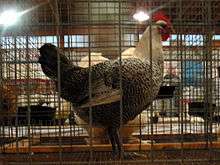Fayoumi
The Fayoumi or Egyptian Fayoumi is an Egyptian breed of chicken. It originates from – and is named for – the governorate of Fayoum, which lies south-west of Cairo and west of the Nile. It is believed to be an ancient breed.[1]:115[5]
_(cropped).jpg) A Fayoumi pullet | |
| Other names |
|
|---|---|
| Country of origin | Egypt |
| Traits | |
| Weight | |
| Skin colour | slate blue |
| Egg colour | white or cream[1]:116 |
| Comb type | single |
| Classification | |
| APA | no[2] |
| EE | no[3] |
| PCGB | rare soft feather: light[4] |
| |
History
The Fayoumi is believed to be an ancient breed.[1]:115
In the 1940s some eggs were imported from Egypt to the United States by a dean of agriculture from Iowa State University, and the birds hatched from them were cross-bred with American chickens. It was believed that the Egyptian birds might have a greater resistance to bacterial and viral infection than the American stock.[6]:54[7] The Fayoumi is not recognized by the American Poultry Association, and is not included in its Standard of Perfection.[2][6]:54
The Fayoumi was first imported to the United Kingdom in 1984. Two colour varieties are recognised, silver-pencilled and gold-pencilled.[1]:116[3]
Characteristics

The Fayoumi has a single comb, with even serrations. The comb, earlobes and wattles are bright red; the eyes are dark brown, the beak and toenails horn-coloured. Two colour varieties are recognised: silver-pencilled and gold-pencilled; the colour pattern of the plumage shows similarity to that of the Belgian Braekel.[1]:116[3]
The bantam Fayoumi is similar to the standard-sized bird in every respect, but weighs about 400 g.[1]:117
Use
The Fayoumi is a hardy breed, well suited to hot climates.[8]:67 It forages well, and is suited to free-range management. Hens lay a good number of small white or cream eggs.[1]:116 They are not given to broodiness as pullets, but can be when they reach two or three years of age. The breed is fast to mature, with hens laying by four and half months, and cockerels crowing at five or six weeks.[6]:54
References
- Victoria Roberts (2008). British poultry standards: complete specifications and judging points of all standardized breeds and varieties of poultry as compiled by the specialist breed clubs and recognised by the Poultry Club of Great Britain. Oxford: Blackwell. ISBN 9781405156424.
- APA Recognized Breeds and Varieties: As of January 1, 2012. American Poultry Association. Archived 4 November 2017.
- Liste des races et variétés homologuée dans les pays EE (28.04.2013). Entente Européenne d’Aviculture et de Cuniculture. Archived 16 June 2013.
- Breed Classification. Poultry Club of Great Britain. Archived 12 June 2018.
- Ducks. Poultry Club of Great Britain. Archived 9 November 2018.
- Carol Ekarius (2007). Storey's Illustrated Guide to Poultry Breeds. North Adams, Massachusetts: Storey Publishing. ISBN 9781580176675.
- Brian Meyer (27 May 1997). Egyptian chicken plan hatches . . . 50 years later. The Iowa Stater. Iowa State University. Archived 22 November 1997.
- Heinrichs, Christine (2007). How To Raise Chickens. Voyageur Press. ISBN 978-0-7938-0601-0.